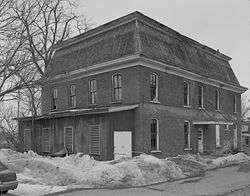Blind Department Building and Dow Hall, State School for the Blind
|
Blind Department Building and Dow Hall, State School for the Blind | |
|
Formerly listed on the U.S. National Register of Historic Places | |
 The Blind Department Building – originally the home of Alexander Faribault – built in 1856 | |
  | |
| Location | Faribault, Minnesota |
|---|---|
| Coordinates | 44°17′12.02″N 93°15′36.21″W / 44.2866722°N 93.2600583°WCoordinates: 44°17′12.02″N 93°15′36.21″W / 44.2866722°N 93.2600583°W |
| Built | 1874 |
| Architect | Waite & Kingsley; Monroe & Shiere |
| Architectural style | Classical Revival, French Second Empire |
| NRHP reference # | 90001092[1] |
| Significant dates | |
| Added to NRHP | July 25, 1990 |
| Removed from NRHP | November 7, 2016 |
Blind Department Building and Dow Hall, State School for the Blind were two buildings that were part of the Minnesota State Academy for the Blind, a public school administered by the state in Faribault, Minnesota, United States. The two structures, Dow Hall and the Blind Department Building, were significant components of a system of state-administered special education for the physically and mentally handicapped segments of the population.[2] Both buildings have been demolished, and their listing was removed from the National Register of Historic Places in 2016.[3]
Blind Department building
Alexander Faribault moved into his impressive Second Empire home on the east side of the Straight River in 1856. In 1874, the home was sold to the state to house the State School for the Blind.[4]
Dow Hall

Dow Hall (1883) was built specifically to house the School for the Blind. The building's construction was indicative not only that education was worthwhile for people with disabilities, but also that differing disabilities required programs tailored to the students' specific needs.[5][6][7]
The building was demolished some time after 1996 due to potential safety hazards. The legislation authorizing the demolition specified that a historical marker must be placed at the site with artifacts of the historic building. The stonework of the ground floor of the foundation is visible at the site.[8]
References
- ↑ National Park Service (2007-01-23). "National Register Information System". National Register of Historic Places. National Park Service.
- ↑ "FARIBAULT STATE SCHOOL AND HOSPITAL". Minnesota Historical Society. Archived from the original on 2007-08-12. Retrieved 2007-11-15.
- ↑ "National Register of Historic Places Program: Weekly List". National Park Service. 2016-11-18. Retrieved 2016-12-13.
- ↑ "Alexander Faribault's French house". Fascinating People of Early Faribault. City of Faribault Heritage Preservation Commission. 2003. Archived from the original on 2008-05-11. Retrieved 2007-11-15.
- ↑ Nord, Mary Ann (2003). The National Register of Historic Places in Minnesota. Minnesota Historical Society. ISBN 0-87351-448-3.
- ↑ "What Stories did State School Buildings Harbor?". Faribault Heritage Preservation Commission. Archived from the original on 2006-09-27. Retrieved 2007-11-15.
- ↑ "Rice County Historical Setting and Resources" (PDF). Rice County. Retrieved 2007-11-15.
- ↑ "Minnesota Session Laws 1996, Chapter 463, Section 6, Subd. 3". Minnesota Office of the Revisor of Statutes.

